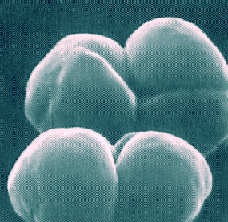Related Research Articles
Chrysiogenaceae is a family of bacteria.
The Thermoprotei is a class of the Thermoproteota.
Rhodobacterales are an order of the Alphaproteobacteria.
In taxonomy, the Methanopyri are a class of the Euryarchaeota.

In taxonomy, the Thermoplasmata are a class of the Euryarchaeota.

In taxonomy, the Thermoplasmataceae are a family of the Thermoplasmatales. It contains only one genus, Thermoplasma. All species within Thermoplasmataceae are thermoacidophiles, and they grow at a temperature of 60 °C and pH 2. They were isolated from hydrothermal vents, fumaroles and similar environments.

In the taxonomy of microorganisms, the Methanomicrobia are a class of the Euryarchaeota.

Methanococci is a class of methanogenic archaea in the phylum Euryarchaeota. They can be mesophilic, thermophilic or hyperthermophilic.

Methanosarcinales is an order of archaeans in the class Methanomicrobia.
In taxonomy, the Methanosaetaceae are a family of microbes within the order Methanosarcinales. All species within this family use acetate as their sole source of energy.

In taxonomy, the Methanosarcinaceae are a family of the Methanosarcinales.
Methanocaldococcus formerly known as Methanococcus is a genus of coccoid methanogen archaea. They are all mesophiles, except the thermophilic M. thermolithotrophicus and the hyperthermophilic M. jannaschii. The latter was discovered at the base of a “white smoker” chimney at 21°N on the East Pacific Rise and it was the first archaean genome to be completely sequenced, revealing many novel and eukaryote-like elements.
In taxonomy, Rhodothalassium is a genus of the Rhodobacteraceae. Up to now there is only one species of this genus known.
In taxonomy, Dinoroseobacter is a genus of the Rhodobacteraceae.
In taxonomy, Haematobacter is a genus of the Rhodobacteraceae.
In taxonomy, Loktanella is a genus of the Rhodobacteraceae.
In taxonomy, Pseudorhodobacter is a genus of the Rhodobacteraceae.
In taxonomy, Rhodovulum is a genus of the Rhodobacteraceae.
Bergey's Manual of Systematic Bacteriology is the main resource for determining the identity of prokaryotic organisms, emphasizing bacterial species, using every characterizing aspect.
Rhodobacter capsulatus is a species of purple bacteria, a group of bacteria that can obtain energy through photosynthesis. Its name is derived from the Latin adjective "capsulatus", itself derived Latin noun "capsula", and the associated Latin suffix for masculine nouns, "-atus".
References
- ↑ Imhoff JF, Truper HG, Pfennig N (1984). "Rearrangement of the species and genera of the phototrophic purple nonsulfur bacteria". Int. J. Syst. Bacteriol. 34 (3): 340–343. doi: 10.1099/00207713-34-3-340 .
- 1 2 List of Prokaryotic Names with Standing in Nomenclature—Rhodobacter
- ↑ Garrity GM, Holt JG (2001). "Taxonomic Outline of the Archaea and Bacteria". In Boone DR, Castenholz RW (eds.). Bergey's Manual of Systematic Bacteriology Volume 1: The Archaea and the deeply branching and phototrophic Bacteria (2nd ed.). New York: Springer Verlag. pp. 155–166. ISBN 978-0-387-98771-2.